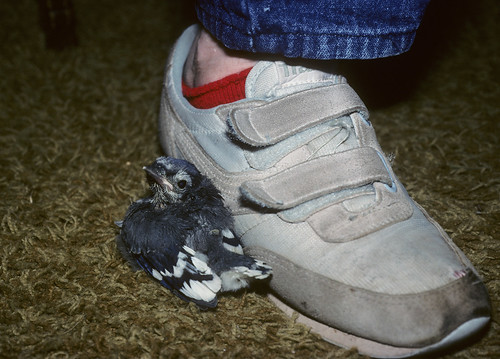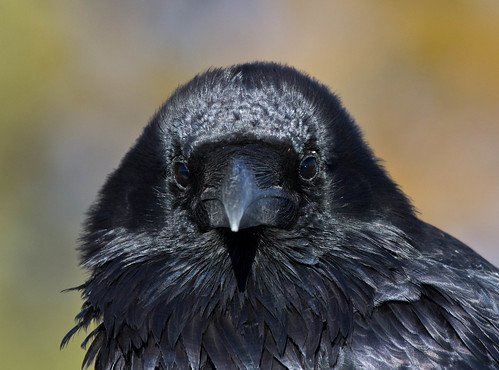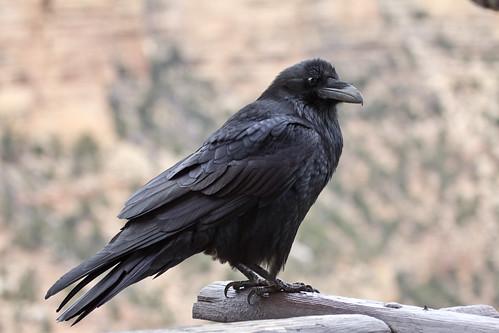Last week I got a fascinating message from a listener named Mike
Bartz who lives up on the Gunflint trail. He writes:
Yesterday I was walking and
observed 3 northern ravens on the ground. They are around all of the time
flying about and scavenging. I noticed that one of them was being pushed
sideways by another. Then I noticed the one being pushed, while it appeared to be
a mature bird its legs were noticeably shorter compared t the other ravens. It
could move on the ground but seemed to have great difficulty compared to the
others.
The closer I looked it became
apparent to me that the bird had some type of birth defect or injury causing
both legs to be grossly misshapen and it appeared that the left foot was
basically held in a knot. I could not get a good view of the right but the bird
seemed to use that one to "shuffle" and put most of its weight on.
Then the one of the most amazing
things I have ever witnessed in nature occurred. On three separate occasions,
the bird that had been pushing or what appeared to be assisting the
"crippled" raven moved off a short distance, picked up something with
its beak, moved back to the handicapped bird, and placed it on the ground. Then
the crippled bird reached down with its beak, and picked up and ate whatever
the first bird had brought to it. I observed this three times in a relatively
short period of time.
The second bird, based on what I
observed, appeared to be feeding the other raven. Helping it. I have seen this
behavior in canines regurgitating food brought back to the pups but never heard
of it among ravens. That handicapped bird appeared to be mature and otherwise
healthy. Wondering if you are aware of any thing in the literature of ravens
helping one another.
Mike continues, “I am a retired game warden from Wisconsin.
If someone had told me this years ago when I was working I likely would have
been skeptical but I know what I saw. It was truly incredible!”
Ravens, along with jays, magpies, and crows, belong to a
family known for tight family relationships, and strong ties with neighboring
birds. One day when I was rehabbing a Blue Jay named BJ, who I kept in a cage
next to my education Blue Jay Sneakers, Sneakers managed to get out of her own
cage. When I came into the room, she was passing mealworms through the bars to
BJ. I bet she’d taken at least a few for herself first, but still…
 |
| Sneakers got her name as a fledgling because she liked to snuggle against our shoes. I don't have photos of B.J. |
BJ came to me in the first place one December after a major
blizzard and frigid weather. Someone found him on the ground beneath their
feeder, and easily picked him up to bring to me. It turned out that BJ had a
congenital deformity and simply could not open his wings at all. Because of
that, or as the root cause of it, his pectoral muscles were almost
non-existent—beneath the chest, I could feel the almost bare keel bone. He was
near starvation when I got him. As he recovered, he was great at hopping and
jumping, and outdoors could easily get from tree to tree if there were low
branches or a nearby shrub. I presume his parents stuck with him from the time
he hatched in early summer until winter became too pressing for them and they
finally had to move on without him. I like thinking that they intentionally
left him near a feeding station so he’d at least not starve.
Kevin McGowan of the Cornell Lab of Ornithology has been
keeping track of individual crows in the Ithaca, New York area since the 70s.
When West Nile Virus hit, it decimated the crow population. Kevin discovered
one male and chicks dead, and both parents in an adjoining territory. The
surviving female went to her neighbors and raised their young. The following
year, at least one of those chicks helped her raise her next family.
We love to pretend our species has a monopoly on
intelligence, compassion, love, and empathy. But if we were indeed as smart as
we think, we might pay a bit more attention to the intelligent and even
compassionate living beings all around us. Thanks, Mike, for this lovely
reminder.

